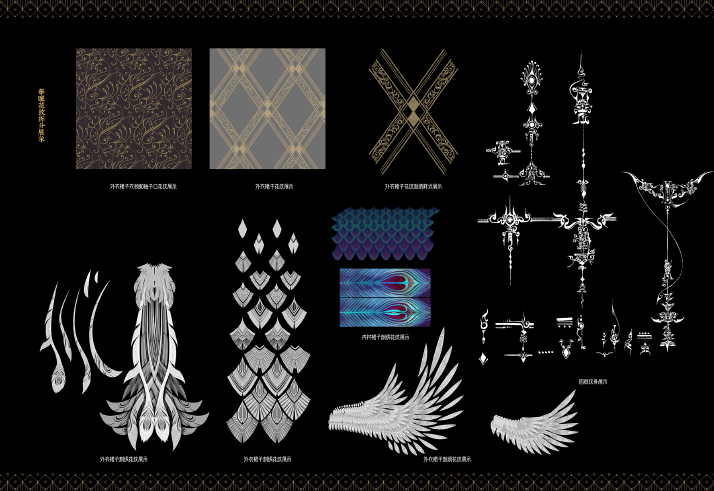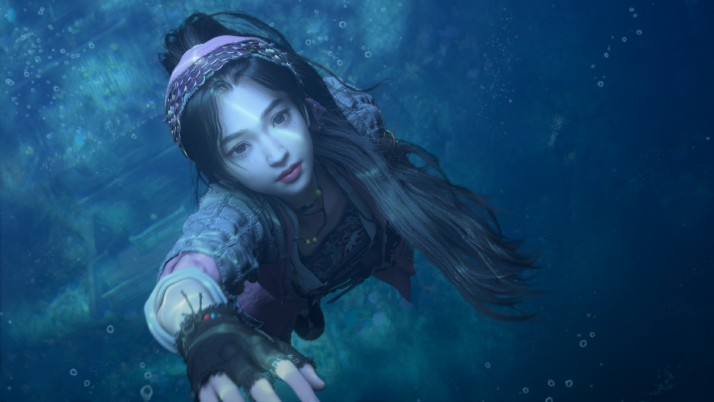| Lifestyle |
| China's animation industry reaches a new milestone | |
|
|
 Costume design details of a figure in The Island of Siliang (COURTESY PHOTO)
What comes to mind when you think of Chinese animation? For many Chinese born in the 1980s and 1990s, animation was an after-school staple. At that time, young Chinese children did not have too many recreational options at their disposal, so watching animation on TV was the general form of entertainment. For Zhao Yuqing, creating her own animation was a teenage dream. It took her 10 years to finally realize it. Despite the solid storyline of The Island of Siliang, Zhao knew that any type of animation, i.e. an original work without a famous online literary work, would face risks in the current market. The 3D-cartoon series tells about the adventures of two young people living in a fantasy world, coexisting with celestial beings, people and gods. The brand-new story is not born out of any ancient mythology, but its every frame exudes the charm of classical Chinese style. Produced by Tencent Penguin Pictures and Year Young Culture animation studio, the first season of The Island of Siliang started airing on Tencent Video on June 14. To Zhao's surprise, audiences were touched by the Chinese cartoon's unique, magical universe as well as the complexity of its characters and the exquisite style with traditional aesthetic. It garnered over 80 million views throughout the first four episodes and has lapped up 8.6 points out of 10 on China's popular review platform Douban.  A screenshot of The Island of Siliang, a 3D-cartoon series released on June 14 (COURTESY PHOTO)
An imaginative outpour This is Zhao's successful exploration of traditional Chinese-style animation. Passionate about traditional culture since childhood, she has her own unique insights. "The art not only condenses the vibe of Eastern culture, but also blends the fashion of modern materials, culminating in a combination of traditional culture and modern perspective," Zhao said. "Just like the 'New Made in China' concept popular in today's fashion and design circles, ancient China featured such a splendid civilization; each dynasty had its own aesthetic," she told Beijing Review. Zhao intends to reinterpret these historical bearings with her own artistic notions combined with animation. "It's time to let more people know just how cool our ancestors were!" "My inspiration hailed from the college entrance examination [also known as gaokao] period when I was in high school," she told Beijing Review. "The high school years were stressful. In order to release some pressure, this story somehow started to shape itself in my mind." In Zhao's words, "The story is about inheritance and liberty. Although it takes place in a fantasy world, it is a reflection of the real world, capturing the emotions between people and the path toward growth of younger generations." Another important element that has attracted audiences lies in the design of the female protagonist in The Island of Siliang. Focusing the narrative on male characters has been a long-standing trope in China's animation industry. Many female characters are designed to forever remain on the periphery and only to be brought out of the shadows to cater to the emotional storyline of the male lead. "The female audience is not as big as the male one in the field of Chinese animation," Zhao sighed, but she still wanted to craft something that zoomed in on a leading lady. "I am a woman. Compared with male directors, I better understand what female audiences want to see," Zhao elaborates. A good-looking character is very attractive, but looks do not make up all the charm women can possess. "I hope that the audience can be touched by the female personalities I created." Beauty lies in the details Many settings in the production relate closely to the period of the Northern and Southern Dynasties (420-589) in ancient China. Zhao has studied some unearthed cultural relics of these dynasties and China's deeper past, such as the Han Dynasty (206 B.C.-A.D. 220) brocade, gold and silver craftsmanship, and tries to incorporate these elements into her cartoon art. The exquisite and meticulous modeling, the fusion of national style and fantasy—all this is inseparable from the exploration of Chinese style 3D modeling system produced by domestic animation creators. "We have paid more attention to details because our 3D modeling is realistic. The hair, the clothes and even the pores of the characters will give audiences a sense of reality," Hu Xiangzi, General Manager of Wulifang, the digital technology company responsible for the cartoon's 3D animation production, told Beijing Review. For example, the appearance of a protagonist's battle injuries, the hair hanging down in perspired strands, and the lines on the lips in close-up all can be clearly seen. Moreover, the characters currently on the stage, regardless of their number of scenes, are all highly recognizable. "The modeling is meticulous and does not make people 'face blind'," Hu said. The eyes of the 9-year-old are smart and dripping with expression. The wrinkles and liver spots on the old man are obviously identifiable, and the imprint of time on a character becomes palpable through their slowing behaviors. Furthermore, animators pay more attention to the micro-expressions of the characters. "In real life, when we are happy and sad, we still have relatively few micro-expressions. Different people have different micro-expressions because of their personalities, living environment and so on," Hu said. To create more detailed and real-life expressions, animators developed a database of expressions and each character now comes with his/her own emoticon pack. "This will be much more convenient for the animator and the animation itself will appear more truthful and intense," Hu told Beijing Review. The design of a 3D animated protagonist takes more than three months, and the average number of model faces exceeds 500,000 polygons, far exceeding that in conventional 2D animation. Opportunities amid challenges The animation industry in China is so young that it has yet to figure out how to make money outside of cinema showings. But things are changing. Today, animated works for kids prove equally fascinating to adults, too. Animation works adapted from online literature are more prominent in terms of viewers, influence, and audience response. Online animated series The Wonderland of Douluo, adapted from popular novelist Tangjia Sanshao's fantasy story, saw its viewership skyrocket to 30 billion as of May, long reigning as the undisputed No.1 on the Chinese animation charts. Plus, Chinese animation is gradually breaking down stereotypes and Chinese watchers are sure to relate to it in their daily lives, even. Diary of Dawang, a cartoon series themed on poverty alleviation, released in January, captured the attention of many children and parents. "In order to make the animation have real power, it focuses on down-to-earth life in warm and funny settings," Zhu Lin, director of Diary of Dawang, told Tencent News. "Each character that appears in it is a microcosm of the participants in the poverty alleviation," she added. Chinese people, especially the younger generations, are gradually embracing a budding subculture of animation, comics and games. According to a report published by marketing agency iResearch, China's online animation market reached 2.68 billion yuan ($414 million) in 2019 and is expected to reach 5.61 billion yuan ($867 million) by 2022. Further, a large amount of capital has entered the Chinese comic and animation industry; implying people today are becoming more aware of its commercial value. Chinese animation is now entering a new era based on the development of online comics and video platforms. (Print Edition Title: Create and Animate) Copyedited by Elsbeth van Paridon Comments to taozihui@bjreview.com |
|
||||||||||||||||||||||||||||
|
